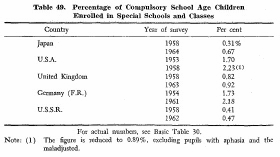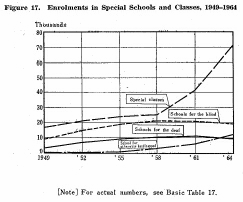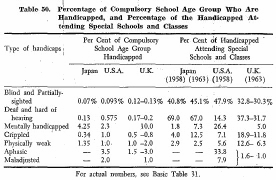| Home > Policy > White Paper, Notice, Announcement > White Paper > EDUCATIONAL STANDARDS IN JAPAN 1965 > CHAPTER |
||
It is necessary that children and pupils with mental and/or physical handicaps be given special education, according to the types and extent of their disabilities, in special schools or classes.


In Japan, the number of children and pupils in these special schools and classes for the handicapped increases year by year. The increase has accelerated in recent years. The number of such special pupils increased nearly 3 times between 1957 and 1964, and more than twice since 1959. The ratio of pupils receiving special education to all pupils of the same level has doubled for the past six years, and the level of special education in Japan is approaching to that in other major countries.
The following table shows the percentage of handicapped children in the total compulsory school population by type of handicaps, and percentage of the handicapped actually attending special schools and classes, in the United States, the United Kingdom and Japan. It is clear that the percentage of mentally retarded is rather high in each country, and that in Japan has relatively high percentage of the blind and partially sighted and the deaf and hard of hearing enrolled in special schools and classes. However, only 7 per cent and 13 per cent, respectively, of the mentally retarded and crippled are enrolled in special schools and classes, although these percentages represent increases of 300 per cent and 200 per cent, respectively since 1955.

In Japan, schools for the blind and for the deaf have already been established in every prefecture, as required by the School Education Law.
The establishment of schools for the mentally retarded, the crippled and the physically weak is not yet required of the prefectural authorities. With the provision since 1956, however, of subsidies from the national budget to cover one half of the expenses for the construction of schools for the mentally retarded, the crippled and the physically weak, the number of those schools has increased remarkably. Also, as a stepping stone for a completely and obligatory enforcement of the establishment of these schools in every prefecture, a ten-year plan was launched in 1964 with nation- al subsidies for the establishment of such schools and special classrooms for the mentally retarded.
The amount of the national budget appropriated for special education in the 1964 fiscal year was 6,140 million yen, an increase of 1,600 million yen as compared with the previous year's budget, with which 16 schools for the handicapped and 1,000 special classrooms were to be newly established during 1964.
For the encouragement of school attendance of the handicapped, about 70 per cent of school children attending special schools are provided a1lowances covering expenses for transportation to and from school; dormitory, board and lodging; school lunches; school tours and for school supplies.Textbooks are provided free to all the handicapped who are attending special schools (elementary, lower and upper secondary divisions). Benefits for the encouragement of school attendance of handicapped children have been provided since 1954 for pupils in compulsory level (elementary and lower secondary) schools.
In recent years, they have been extended to pupils of kindergartens and upper secondary schools, and have also been increased year by year both in items of expenditure and in amount per pupil.
The training of special school teachers has been conducted exclusively by state universities. However, to meet an acute shortage of prospective special teachers in universities other provisions have been made. Seminars for in-service training of teachers in special education have been set up and emergency training courses established in universities. Particularly in response to the demand for a complete and obligatory establishment of schools for the mentally retarded, the crippled and the physically weak, various courses for preparing and training of teachers for such schools have been organized at state universities since 1960 on the basis of a planned program.
To improve the content of special education, the Ministry of Education has conducted since 1962 the preparation of curricula for schools for the blind, the deaf, the mentally retarded, the crippled and the physically weak. At the same time, it has been engaged in improving and compiling textbooks for these schools.
| Back to Top | MEXT HOME |